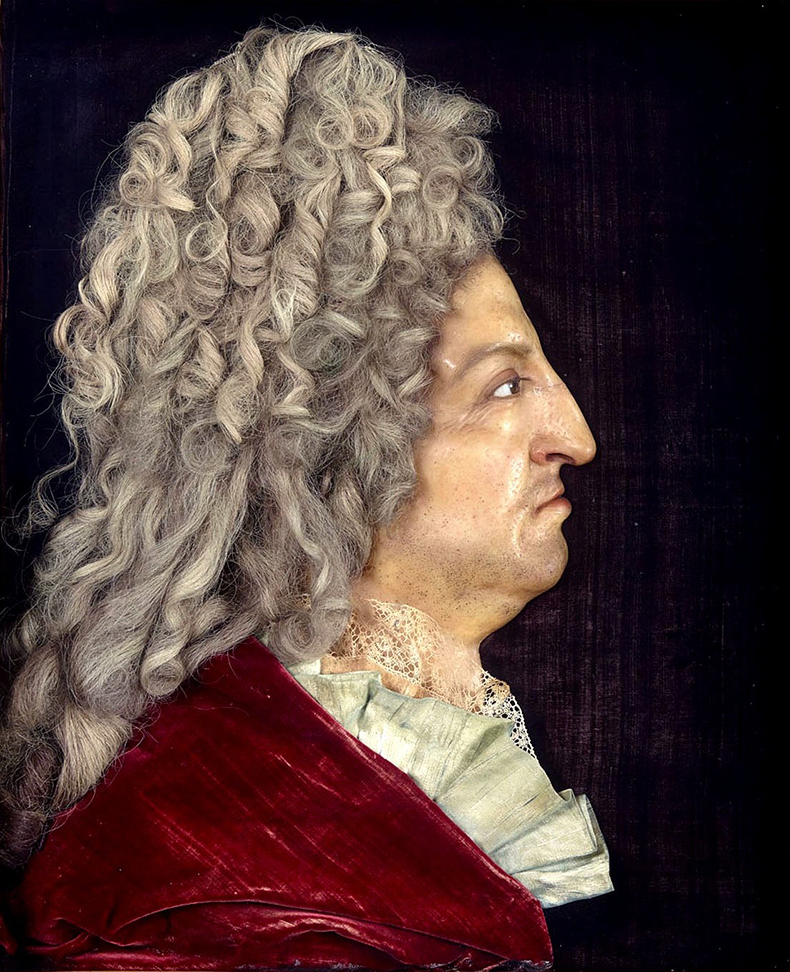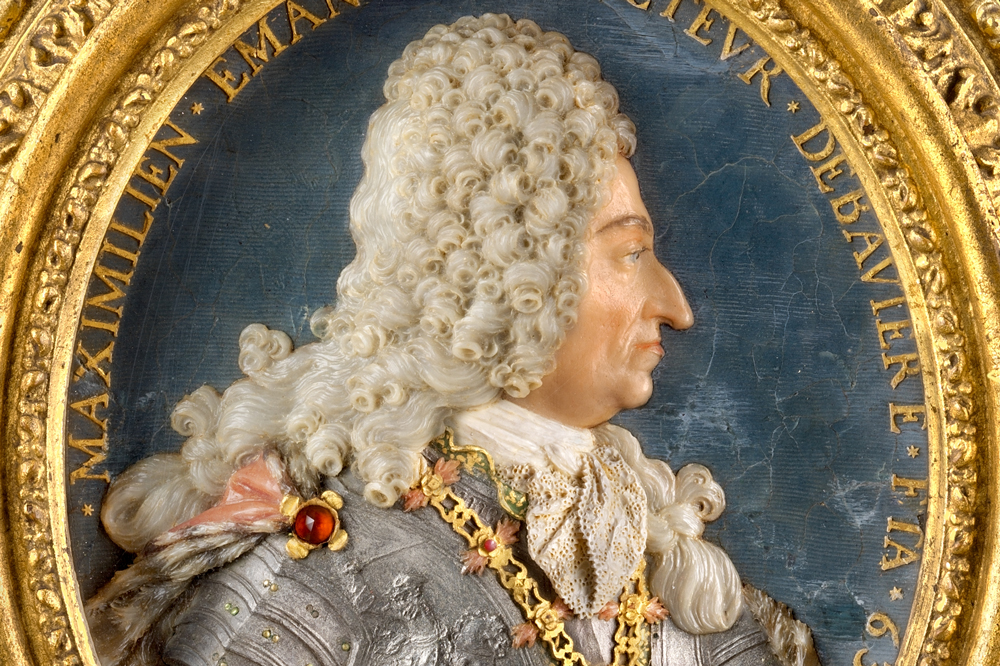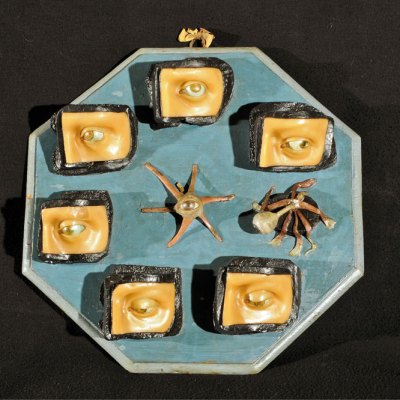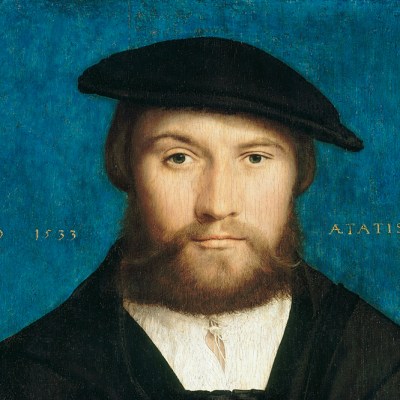In 1704, Hadji Mustapha Aga was in Paris as the Muslim diplomat of Ottoman Tripoli. There, among the spectacles of the late, decadent France of Louis XIV, he saw Antoine Benoist’s wax bust of the duchess of Noailles. The sculpture was too close to life, he said. On the Day of Judgment, the sculpture would demand a soul from its maker, and Allah would condemn Benoist to Hell ‘for having so closely approached a divine work with his creature, and yet for having made it without being able to give it a soul.’ Looking at Benoist’s wax profile of Louis XIV from the same period, with its glass eye and human hair, makes it hard to disagree that wax is the most cursed of all art forms. One day, these misbegotten creatures will seek revenge on their creators.
Portrait of Louis XIV at 68, Seven Years Before His Death (1706), Antoine Benoist. Château de Versailles. Photo: Wikimedia Commons/public domain

A selection of works that tells the story of the strange career of wax in Europe is now on view in a single niche of the side gallery of the Bode Museum in Berlin. There, even visitors used to European art history can have Hadji Mustapha Aga’s Parisian experience of glimpsing a bizarre world behind glass. With two vitrines augmented by nine stand-alone pieces, the show charts the beginnings of wax portraiture on the faces of Renaissance medals, follows it through its heyday of uncanny three-dimensionality around 1700, and reaches its more expansive possibilities in the 18th century. In doing so, it follows a path first sketched by the Viennese art historian Julius von Schlosser in his classic book-length journal article, ‘History of Portraiture in Wax: An Essay’ (1911). ‘Here we are dealing with a branch of art,’ he wrote, ‘which today is only encountered in a region almost completely withdrawn from what we think of as “art” – that is, in the stalls of annual fairs, in barber shops, and in butchers – but which flourished for two millennia, right up to the threshold of our own time, and which has a remarkable past.’
The exhibition describes the northern Italian artist Antonio Abondio (1538–91) as the first genuine master of this art in the Renaissance, and whoever scrutinises the first display case, full of early wax portraits in profile, will agree. The Portrait of a Knight of the Golden Fleece, ascribed to Abondio, is the only piece among these earliest portraits in which a hand is attempted and it achieves an unusual level of characterisation. Nearby is John Calvin, ironically, in whose name thousands of iconoclasts destroyed painted images and sculptures across Europe.
One of the unexpected lessons of the exhibition is how often early modern wax merely imitated other mediums. The beautiful 18th-century Spanish panels, one of St. Jerome in the desert and another of Mary Magdalene, look as though they have been sculpted in ivory or alabaster; the bust of a grimacing actor could be porphyry, and the large, 19th-century sculpture of Charles V in armour might as well be in bronze.
St Mary Magdalene in the Desert (early 18th century), Italy. Photo: © Staatliche Museen zu Berlin, Skulpturensammlung und Museum für Byzantinische Kunst/Antje Voigt

There are, though, a few figures here, clothed in real jewels and authentic textiles, who represent the strange realism of sculpted wax. Among them are Johann Wilhelm von der Kolm’s twin busts of Frederick III, who was the first king of Prussia, and his wife, Sophie Charlotte of Brandenburg, from 1700. (A life-size, seated wax sculpture of the same king from the same period, a photograph of which is illustrated in Schlosser’s essay, was destroyed in 1945.) But the realism is somehow too much; even Schlosser admits, when discussing a wax sculpture of Ferdinand IV of Naples, that its trueness to life comes across as an ‘indiscretion’. In front of Frederick III and Sophia Charlotte, it is possible to feel, with Schlosser, the dissonance of European rulers appearing as antique-store mascots.
Left: Elector Frederick III of Brandenburg (1657–1713), right: Sophie Charlotte, Electress of Brandenburg (1668–1705) (1700), Johann Wilhelm von (der) Kolm the Elder. Photo: © Staatliche Museen zu Berlin, Skulpturensammlung und Museum für Byzantinische Kunst/Antje Voigt

The objects on display here were mostly donated by James Simon, a collector and businessman who patronised the Bode Museum when it opened as the Kaiser-Friedrich-Museum in 1904, looming over the Spree in imperial Berlin. In fact, it is possible to think of Schlosser’s book and Simon’s collection as simultaneous reckonings with wax in the capital cities of early 20th-century Europe, Vienna and Berlin. Schlosser argued that by democratising who was portrayed, wax portraiture faced its demise as a serious art form, and indeed the show includes not just a comic actor in wax but also an old Dutch couple bickering. ‘Thus the departure from the status of artistic craft, which enjoyed courtly patronage all the way to the threshold of the nineteenth century, began; today its proletarianisation is complete.’ But of course this proletarianisation had one more step to go. Within 15 years of the opening of the museum, and within 10 years of Schlosser’s essay, both the German and the Austro-Hungarian empires had also ceased to exist. Wax portraiture, like the politics for which it is a seismograph, fell further down among the people. Now, on the Day of Judgment, it will not just be the monarchs and noblemen who demand souls, but actors, musicians and celebrities too.
‘Sculptures in Wax’ is at the Bode Museum, Berlin, until 17 July.



